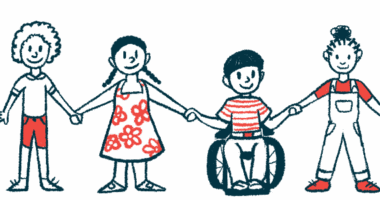Muscle contractures minor bother for SMA patients who can’t walk
Young adults voice opinions on efforts to preserve joint muscle and tissue
Nonambulatory young adults with spinal muscular atrophy (SMA) who have contractures — when muscle and connective tissue around a joint become short and hardened — do not feel significantly hindered by these in their daily lives. Despite contractures in multiple joints, they do not perceive them as a constant obstacle to their everyday activities.
As disease-modifying treatments (DMTs) raise the possibility of better motor function, however, “their perspective on contracture management would change,” according to the interview study, conducted with a small group of SMA type 2 and 3 patients in the Netherlands.
The study, “Impact of contractures on daily functioning in adolescents with spinal muscular atrophy: a qualitative study,” was published in Disability and Rehabilitation.
Stretching seen to help, but muscle contractures a given with SMA
Contractures are a common SMA symptom. As stiffness around joints can be painful and interfere with movement, it’s generally assumed that contractures substantially impact the comfort and functionality of people with SMA. However, there hasn’t been much formal research assessing how patients themselves feel about their contractures.
A team of scientists at University Medical Center Utrecht conducted interviews with 14 young adults with SMA, ages 16 through 30. Two had type 3 disease while the rest had type 2 SMA; all of the patients were unable to walk and had multiple contractures.
In general, these young people reported feeling that their contractures didn’t cause much discomfort or interfere with their day-to-day life. “I know that I have contractures, but I’m not hindered by the contractures,” one patient said.
Since contractures tend to develop slowly over time as muscle weakness in SMA worsens, patients generally said that they felt used to their contractures and what their body was able to do.
“I am used to moving my arm only in a reduced range, because my muscles don’t have the strength to move in the complete range of motion,” one said.
Contractures in the legs, in particular, were not viewed as an issue for these patients who cannot walk. “To me, there is no need to extend my legs, why should I?” one patient said. Another said, “I mainly have contractures in my lower extremities, which I don’t really use, so the contractures don’t bother me.”
A few reported that contractures sometimes caused issues with getting dressed, hygiene, or finding comfortable positions during sexual intimacy, but these generally were seen as manageable. In a handful of reports, patients noted experiencing pain when doctors positioned their limbs poorly during surgical procedures.
‘My hands and arms are the only extremities I can still use’
Researchers asked the patients about treatments given in early life aiming to help prevent contractures from developing. Some interventions, particularly stretching as part of physical therapy, were viewed positively, with patients reporting it could help them feel less stiff.
Some also favored efforts to delay or prevent the start of contractures in their hands, as they could affect their ability to function.
“I think I would be upset if the contractures worsened. Because my hands and arms, they are the only extremities I can still use. So I would hate it if the contractures would become as bad as in my knees,” one said.
However, patients criticized interventions aiming to prevent contractures when the contracture itself would not substantially impact their motor abilities. For instance, several mentioned having been put in a stander to help stretch out their knees — but since knee contractures do not affect their ability to function, these interventions were generally seen as pointless.
“I didn’t see the need to stand. I sit all day, so why in god’s name would I want to stand in a stander?” one patient remarked.
Another said that being put in a stander, rather than being given wheelchair approaches, made them feel less independent: “I lose my freedom and control, that has always been important to me. To be able to decide where I want to go and when I want to go there. And not having to be moved by someone else.”
Most of these young adults “felt strongly that contracture treatment should provide a clear benefit,” the researchers wrote.
DMTs likely to change priorities for next SMA generation
The patients noted, however, that these considerations might not apply for the next generation of children with SMA, born into a world with DMTs that can slow or stop the disease’s progression. For children who might retain more motor function over time, preventing contractures may be more of a priority, they said.
“If children are able to stand with the help of DMT, I would definitely advise using contracture management. There is a different goal with contracture management now in comparison to myself, since I can’t stand,” said one patient.
“I think it is different now in children with DMT. In my case it did not matter, I wouldn’t use my legs anyway,” another said. “But now I think it is more important to prevent contractures instead of trying to influence them while contractures progress.”
Overall, the researchers said this study highlights the importance of shared decision-making for contracture management in SMA, making sure that the goals of treatment are clear and in line with the desires of the person who is actually living with the disease. Such an alignment will be of particular importance for the next generation of patients, who start on DMTs early in life.



